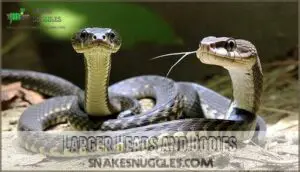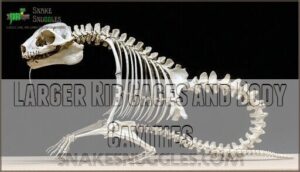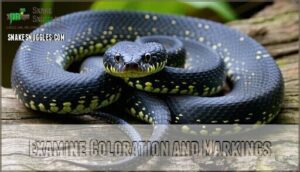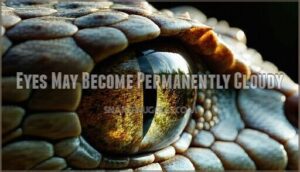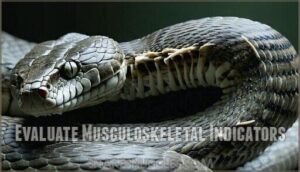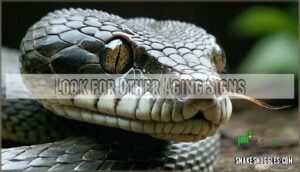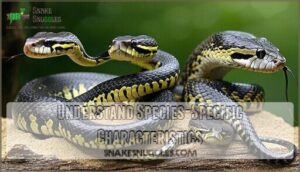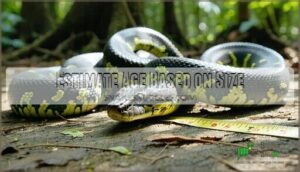This site is supported by our readers. We may earn a commission, at no cost to you, if you purchase through links.
 You can’t count rings like a tree, but learning how to age a snake involves spotting key physical changes.
You can’t count rings like a tree, but learning how to age a snake involves spotting key physical changes.
Look for broader heads relative to neck size, duller coloration, and decreased muscle tone along the spine.
Older snakes often develop "salt and pepper" speckling on their scales and may show cloudiness in their eyes.
Since snakes grow throughout their lives, size alone won’t tell the whole story.
Battle scars, reduced appetite, and less activity also hint at advanced age.
While you won’t get an exact number, combining these observations paints a clearer picture of whether you’re dealing with a youngster or seasoned serpent.
Table Of Contents
- Key Takeaways
- How to Age a Snake?
- Understand Snake Growth Patterns
- Observe Physical Changes With Age
- Examine Coloration and Markings
- Assess Head and Eye Changes
- Evaluate Musculoskeletal Indicators
- Look for Other Aging Signs
- Understand Species-Specific Characteristics
- Estimate Age Based on Size
- Frequently Asked Questions (FAQs)
- How can you tell a snake’s age?
- How old is 3 years in snake Years?
- What are the signs of aging in snakes?
- What are the age stages of snakes?
- How can you tell how old a baby snake is?
- Do snakes show signs of aging?
- Do snakes get longer as they age?
- What is the minimum snake age?
- How old is a snake?
- How do you age a snake accurately?
- Conclusion
Key Takeaways
- You can’t rely on size alone to determine age since snakes grow continuously throughout their lives, and environmental factors like diet and habitat significantly affect their growth rates.
- Look for physical changes like broader heads relative to neck size, duller coloration with "salt and pepper" speckling, loss of muscle tone along the spine, and permanently cloudy eyes that don’t clear after shedding.
- Observe behavioral indicators such as decreased appetite, reduced activity levels, and accumulated battle scars in wild snakes, as these signs become more pronounced with advancing age.
- You’ll need to combine multiple aging techniques and compare observations across different specimens since there’s no single reliable method, and aging accuracy varies significantly between snake species.
How to Age a Snake?
Figuring out snake age estimation isn’t straightforward since reptile age determination involves multiple aging challenges.
You’ll need to look beyond size and examine physical changes like duller colors, broader heads, and muscle loss.
Snake aging techniques require observing behavioral clues too, though expert disagreements exist about conversion accuracy.
Multiple lifespan factors make determining snake age complex but achievable.
Understand Snake Growth Patterns
You’ll find that snakes follow unique growth patterns that differ substantially from mammals, making age estimation a complex process that requires understanding their continuous growth throughout life.
Unlike humans who stop growing at maturity, snakes keep growing their entire lives, though their growth rate slows considerably after reaching sexual maturity at 2-3 years old, which is a key factor in their overall growth patterns.
Snakes Continue Growing Throughout Their Lives
Unlike mammals, a snake’s growth rate never truly stops—they’ll keep adding length throughout their entire lifespan.
This continuous growth makes snake age estimation tricky since environmental factors and dietary impact substantially influence development.
Species variation also affects lifespan correlation, meaning two snakes of identical size could be vastly different ages, complicating traditional snake aging techniques.
Size is Not an Accurate Indicator of Age
Don’t rely on size alone for snake age determination – it’s like judging a book by its cover.
Environmental factors and diet impact create huge growth variability between individuals. A well-fed young snake might outsize a malnourished older one.
Genetic influence and individual differences make snake size age correlation unreliable.
These snake aging challenges highlight why snake aging indicators require multiple observations for snake age accuracy.
Older Snakes May Have Wider Heads
Notice how aging snakes develop broader heads as their skull growth continues throughout life.
This head size expansion occurs from strengthened jaw muscles and increased cranial capacity. However, species variation affects this snake age indicator substantially.
Their locomotion methods also change over time.
Here’s what to look for in snake age determination:
- Wider skull compared to body proportions
- More prominent jaw muscle definition
- Increased cranial width behind the eyes
- Enhanced overall head mass relative to neck
Observe Physical Changes With Age
You’ll notice physical changes as snakes age that aren’t immediately obvious but become clear with careful observation.
These subtle transformations include changes in body symmetry, head proportions, and overall body structure that develop over years of growth.
Subtle Changes in Symmetry
Aging snakes develop subtle Scale Asymmetry that reveals their true age. Pattern Distortion becomes noticeable as developmental disturbances accumulate over time, creating deviations from perfect symmetrical scales.
Pareatid snakes exhibit jaw asymmetry linked to their diet.
- Scale pattern irregularities – Notice uneven spacing or misaligned ventral scales
- Body Shape variations – Observe slight curves or asymmetrical positioning
- Facial Features asymmetry – Check for uneven head proportions or crooked jaw alignment
These snake age indicators help identify older specimens.
Larger Heads and Bodies
Head morphology becomes more pronounced as snakes mature, with head size increasing noticeably relative to body proportions.
You’ll spot wider skulls and thicker necks in older specimens.
Body size expands through skeletal growth and organ enlargement, though muscle mass may decrease.
These snake aging indicators help distinguish juveniles from adults when using proper snake aging methods to assess snake size variation.
Larger Rib Cages and Body Cavities
Beyond head size, aging snakes develop noticeably expanded rib cages and body cavities.
This organ expansion reflects skeletal growth that continues throughout their lives.
You’ll observe increased cavity volume supporting larger organs and prey consumption.
These body proportions change substantially with snake aging.
- Expanded ribcage creates a barrel-shaped torso in mature specimens
- Organ displacement becomes visible as internal space increases substantially
- Body size variation between juveniles and adults shows dramatic morphological differences
Examine Coloration and Markings
You’ll notice that a snake’s colors and patterns change as it ages, with older snakes typically showing duller, faded colors compared to their vibrant younger selves.
Look for small salt-and-pepper dots that appear on the body over time, especially in darker species where these age spots become more visible.
Older Snakes May Have Duller Colors
You’ll notice color fading as your snake ages – those once-brilliant patterns become muted and washed out.
Pigment changes occur naturally over time, causing scale dullness that’s particularly noticeable in species with vibrant markings.
UV exposure accelerates this process, making pattern shifts a reliable indicator for aging snakes accurately.
This snake coloration change helps with snake age identification among other aging indicators.
Salt and Pepper Dots May Appear on The Body
Speckled patterns reveal fascinating snake aging characteristics through melanin distribution changes. As snakes mature, scale pigmentation shifts create distinctive salt-and-pepper appearances on darker bodies.
These aging snakes accurately display dot density variations that help with snake scale analysis. The Black Speckled Kingsnake, also known as Lampropeltis nigra, exhibits these patterns.
Key reptile age indicators include:
- Pattern changes from uniform coloration to speckled designs
- Genetic factors influencing how dots develop over time
- Scale borders showing cream or yellow accents with age
Albinos May Develop Fatty Lumps
Albino snakes often develop fatty lumps called albino lipomas as they age.
These benign growths show genetic predisposition in captive snakes, appearing on various body sections.
Tumor location and growth rate vary between individuals.
While veterinary intervention isn’t always necessary, these lumps help with estimating snake age and monitoring snake health in aging captive snakes.
One potential cause could be internal or external abscesses.
| Age Range | Lipoma Frequency | Typical Location | Growth Rate |
|---|---|---|---|
| 0-5 years | Rare | N/A | N/A |
| 6-10 years | Moderate | Body/neck | Slow |
| 11+ years | Common | Multiple sites | Variable |
Assess Head and Eye Changes
You’ll notice a snake’s head becomes broader and more triangular as it ages, while the eyes may develop a permanent cloudy appearance that doesn’t clear between sheds.
These changes occur gradually over years, making head and eye examination one of the most reliable methods for estimating an older snake’s age.
Head May Become Broader With Age
As snakes age, their skull development creates noticeable changes in head proportions.
You’ll observe broader heads due to enhanced jaw musculature and cranial morphology shifts.
This snake aging sign varies by species variation, making head size a reliable indicator for estimating snake age.
Compare younger specimens to older ones—the difference in snake morphology becomes clear with practice.
Vipers May Lose Fangs More Readily
Beyond head width, check for fang loss frequency in aging vipers. Older specimens can’t regenerate fangs as efficiently, affecting venom delivery impact.
This snake aging indicator varies by species and captive viper longevity. Aging wild snakes show more fang wear from hunting, while captive ones may retain fangs longer due to diet adaptations.
Key fang assessment points:
- Compare fang symmetry between left and right sides
- Look for broken or missing fang tips in older vipers
- Note regeneration quality differences in mature specimens
Eyes May Become Permanently Cloudy
One telltale sign of advancing snake age involves permanently cloudy eyes that won’t clear after shedding.
Unlike temporary pre-shed cloudiness, aging-related vision impairment stems from cataract formation or eye infections that accumulate over time.
| Cloudy Eye Causes | Age Range | Reversible |
|---|---|---|
| Pre-shed opacity | Any age | Yes |
| Cataracts | 8+ years | No |
| Chronic infections | 5+ years | Sometimes |
These aging indicators help determine your snake’s approximate age through observable physical characteristics.
Evaluate Musculoskeletal Indicators
You’ll notice that aging snakes often show clear changes in their body structure, particularly in muscle tone and spine appearance.
These physical changes can help you determine if your snake is entering its senior years, though some species like garter snakes don’t display obvious musculoskeletal aging signs.
Loss of Muscle Tone is a Sign of Aging
Through careful observation, you’ll spot muscle atrophy as a key snake aging sign affecting their physical capabilities.
This muscle deterioration impacts their overall strength and mobility patterns.
Watch for these telltale signs:
- Reduced flexibility during movement and coiling behaviors
- Weaker grip strength when handling or climbing surfaces
- Slowed movement patterns compared to younger specimens
These snake maturity signs indicate declining physical condition in aging reptiles.
Older Snakes May Have a Protruding Spine
As muscle atrophy progresses, you’ll spot a protruding spine along your snake’s back.
This spinal degeneration creates visible vertebral deformities and skeletal changes that signal aging.
Limited flexibility becomes apparent when handling older serpents.
Consult your veterinarian if you notice pronounced spine visibility – it’s a key snake aging sign among important snake physical features.
| Age Stage | Spine Appearance | Muscle Condition |
|---|---|---|
| Young | Smooth, rounded back | Full muscle coverage |
| Middle-aged | Slight ridge visible | Moderate muscle loss |
| Senior | Prominent spine protrusion | Significant muscle atrophy |
Garter Snakes May Not Show Signs of Aging
Unlike other reptiles, garter snakes challenge conventional snake aging wisdom.
These hardy creatures often maintain youthful appearances even after a decade in captivity, making snake age estimation particularly tricky.
Watch for these subtle garter changes:
- Minimal skeletal growth over time
- Maintained muscle tone despite advanced age
- Consistent activity levels throughout garter longevity factors
- Absence of typical captive garter aging signs
garter-snake-aging-content
text/markdown
Garter Snake Aging Content
Unlike other reptiles, garter snakes challenge conventional snake aging wisdom.
These hardy creatures often maintain youthful appearances even after a decade in captivity, making snake age estimation particularly tricky.
Watch for these subtle garter changes:
- Minimal skeletal growth over time
- Maintained muscle tone despite advanced age
- Consistent activity levels throughout garter longevity factors
- Absence of typical captive garter aging signs
Look for Other Aging Signs
Beyond the obvious physical changes, you’ll notice other subtle signs that reveal a snake’s age through careful observation.
These additional indicators include battle scars from wild encounters, mouth deformities, and changes in eating habits that develop over time, which can be considered as subtle signs.
Battle Scars May Accumulate in The Wild
Wild snakes often carry battle scars that tell their life stories.
You’ll notice healed bite marks from predator encounters, missing tail tips, and damaged scales that reveal years of survival.
These scars accumulate over time, making scar tissue analysis a valuable tool for estimating snake age.
Older wild snakes typically show more environmental impact evidence than younger specimens.
Lethargy can be one of the signs your snake is unwell, indicating that your snake may be unwell.
Snakes May Develop a Permanently Gaping Mouth
Beyond battle scars, aging snakes often develop a permanently gaping mouth—their jaws simply won’t close properly anymore.
This mouth gape causes stem from jaw misalignment, dental disease, or arthritis that accumulates over time.
While mild gaping mightn’t affect feeding, severe cases create infection risks and require treatment options from exotic veterinarians specializing in snake aging signs.
Decreased Appetite and Activity Levels
An aging snake’s appetite often becomes their tell-tale sign of advancing years. You’ll observe reduced hunting frequency and slower digestion changes as metabolic slowdown kicks in.
Watch for these key indicators:
- Extended periods between meals
- Reluctance to strike at prey
- Longer digestion times after feeding
- Decreased movement during normal activity periods
Thermoregulation impact and brumation effects also influence these aging signs in snake behavior. Some owners consider using a snake appetite stimulant for older snakes to help with appetite stimulant needs.
Understand Species-Specific Characteristics
Different snake species show unique growth patterns and aging characteristics that you’ll need to recognize for accurate age estimation.
Ball pythons reach different sizes than corn snakes at the same age, while king snakes display distinct weight-to-length ratios that change as they mature.
Hatch at 12-18 Inches Long
Most snake species begin life at surprisingly consistent sizes, though hatchling size varies by species.
You’ll find most newborns measure between 12-18 inches at birth, regardless of their eventual adult length.
| Age Stage | Typical Length |
|---|---|
| Hatchling | 12-18 inches |
| 6 months | 24-30 inches |
| 1 year | 36-48 inches |
| Adult | Species-dependent |
This initial growth pattern helps determine snake age during juvenile development stages.
You can find products for hatchlings online.
Fully Equipped to Devour Rodents
Despite their young snake age, these newly hatched predators possess remarkable hunting techniques that rival adults.
Their jaw flexibility allows them to consume prey twice their head width, while digestive efficiency breaks down entire rodents within days.
Understanding their diet, including essential vitamin D3, is vital for proper care.
Consider these three key adaptations for snake age estimation:
- Venom potency reaches adult levels immediately
- Prey preference matches body size perfectly
- Constriction strength develops rapidly after hatching
Become Tame When Handled Young
Young snakes develop remarkably calm temperaments through Early Handling, creating lasting Domestication Effects that influence snake age estimation methods.
This Temperament Influence reduces defensive behaviors, making snake aging assessments easier as handlers can examine physical characteristics without stress responses.
For safe handling, consider using appropriate protective gear.
Habituation Benefits include Reduced Stress during examinations, allowing for better snake age approximation through detailed observation.
| Age Group | Handling Frequency | Temperament Result |
|---|---|---|
| Hatchling | 2-3 times weekly | Accepts human contact |
| Juvenile | Daily brief sessions | Reduces defensive striking |
| Adult | Regular maintenance | Remains calm during exams |
Estimate Age Based on Size
You can estimate a snake’s age by measuring its length, though this method works best when you know the specific species.
Most snakes grow rapidly during their first few years, reaching adult size by age three, but growth continues at a slower rate throughout their entire lives, which can help in estimating their age more accurately.
Baby Snakes: 2-4.5 Inches Long at Hatching
Hatchling size matters when estimating age. Baby snakes emerge at just 2-4.5 inches, making them incredibly vulnerable despite their hunting abilities.
Their initial growth and first shed occur within days, signaling rapid development.
Watch for these key indicators:
- Tiny proportions that make you marvel at nature’s precision
- Lightning-fast growth rate that amazes new snake owners
- Immediate feeding capability that defies their fragile appearance
Juveniles: 12-18 Inches Long at Hatching
Juvenile snakes measure 12-18 inches at hatching, showcasing vibrant markings and energetic behavior.
Their hatchling size indicates rapid growth rate during early development.
These young serpents display high activity levels while establishing territory, making juvenile care essential.
You’ll notice their striking patterns remain sharp and colorful, helping distinguish them from older specimens when determining snake age.
Mature Snakes: Average 5 Feet Long
Most adult snakes reach their prime around 5 feet long, marking true maturity beyond simple length measurements.
Adult snake size varies substantially between species—captive versus wild environments affect growth rate decline differently.
When evaluating snake age through length and maturity indicators, remember that species size variation means a 5-foot snake could range from middle-aged to elderly, depending on genetics and care.
Involves Observing Numerous Snakes
Developing expertise in snake aging requires extensive field research and comparative analysis.
You’ll need to study multiple specimens across different habitats to understand population age structure and comparative growth rates.
Wild snake studies provide the most reliable longitudinal snake data.
- Habitat age impact varies substantially between environments and species
- Snake age research demands years of consistent observation and documentation
- Snake aging experience improves accuracy through repeated encounters with diverse populations
Frequently Asked Questions (FAQs)
How can you tell a snake’s age?
You can’t pinpoint exact age, but you’ll estimate using length, weight, and physical traits.
Measure your snake’s size, check scale condition, and compare to species-specific growth charts for approximate age ranges.
How old is 3 years in snake Years?
Snake age conversion isn’t straightforward since there’s no universal formula.
A 3-year-old snake equals roughly 30 human years using general estimates, but you’ll need species-specific calculations for accuracy since lifespans vary dramatically, and this is due to the need for accuracy.
What are the signs of aging in snakes?
You’ll notice older snakes have worn, dull scales and faded colors.
Their rattles become darker and more weathered.
Growth slows substantially, and they’re less aggressive, preferring solitude over the energetic behavior of younger snakes.
They become less energetic as they age, and their behavior changes to prefer solitude.
What are the age stages of snakes?
Like lightning-fast transformations, snakes progress through distinct life stages.
You’ll observe hatchlings (newborns), juveniles (under 2 years), subadults (2-3 years reaching sexual maturity), and adults (3+ years with continued growth throughout their lives).
How can you tell how old a baby snake is?
You can determine a baby snake’s age by measuring its length and weight, then comparing these to species-specific growth charts.
Hatchlings are typically 4-16 inches long, while yearlings reach 20-40 inches depending on species.
Do snakes show signs of aging?
Yes, you’ll notice older snakes develop worn scales, faded colors, and larger body size.
Their rattles become darker and more weathered.
Behavioral changes include increased caution and less aggressive responses compared to younger snakes, showing increased caution.
Do snakes get longer as they age?
Snakes continue growing throughout their entire lives, though growth slows substantially after reaching sexual maturity around 2-3 years old.
You’ll notice older snakes are typically longer than average adults of their species, which can be considered a complete concept related to the growth of snakes.
What is the minimum snake age?
Hatchlings represent the minimum age at zero years old when they first emerge from eggs or are born live.
You can’t determine age below this point since snakes don’t exist before hatching or birth.
How old is a snake?
Age varies dramatically by species and individual factors.
You can’t pinpoint exact age without knowing hatching date, but size, weight, and physical condition provide clues for rough estimates between juvenile and adult stages.
How do you age a snake accurately?
You’ll need to measure length and weight, then compare against species-specific growth charts.
Check scale condition and body proportions too.
There’s no perfect method, but combining these factors gives you the best age estimate.
Conclusion
Determining a snake’s age remains challenging even for experienced herpetologists, but you’ve now learned the essential markers.
While you can’t precisely determine years like counting tree rings, combining physical indicators gives you reliable estimates.
Watch for broader heads, dulled coloration, muscle tone changes, and cloudy eyes.
Remember that learning how to age a snake requires patience and practice observing multiple specimens, and these techniques help you distinguish between juvenile serpents and their weathered, experienced counterparts in the wild, which is a key aspect of understanding snake behavior.



